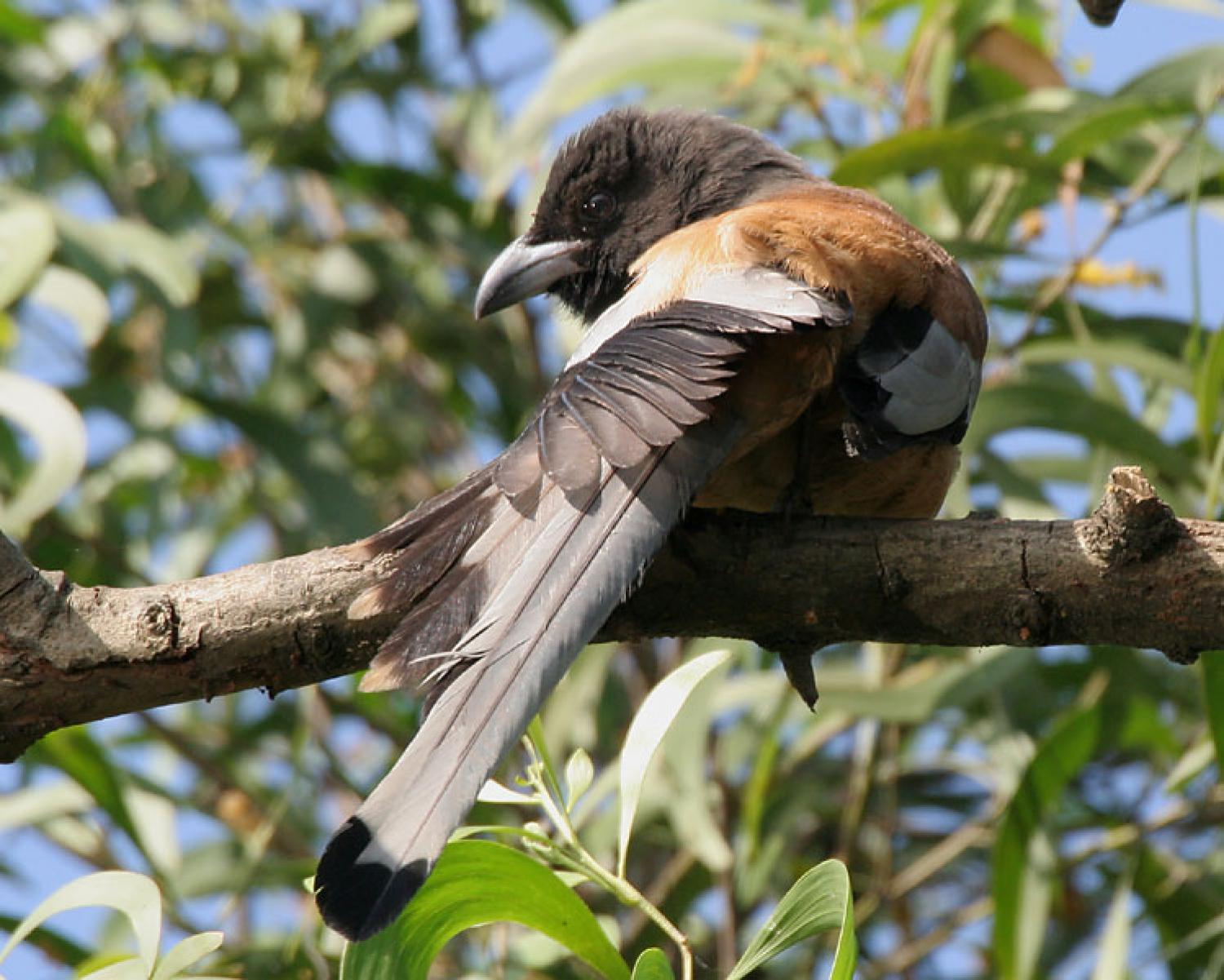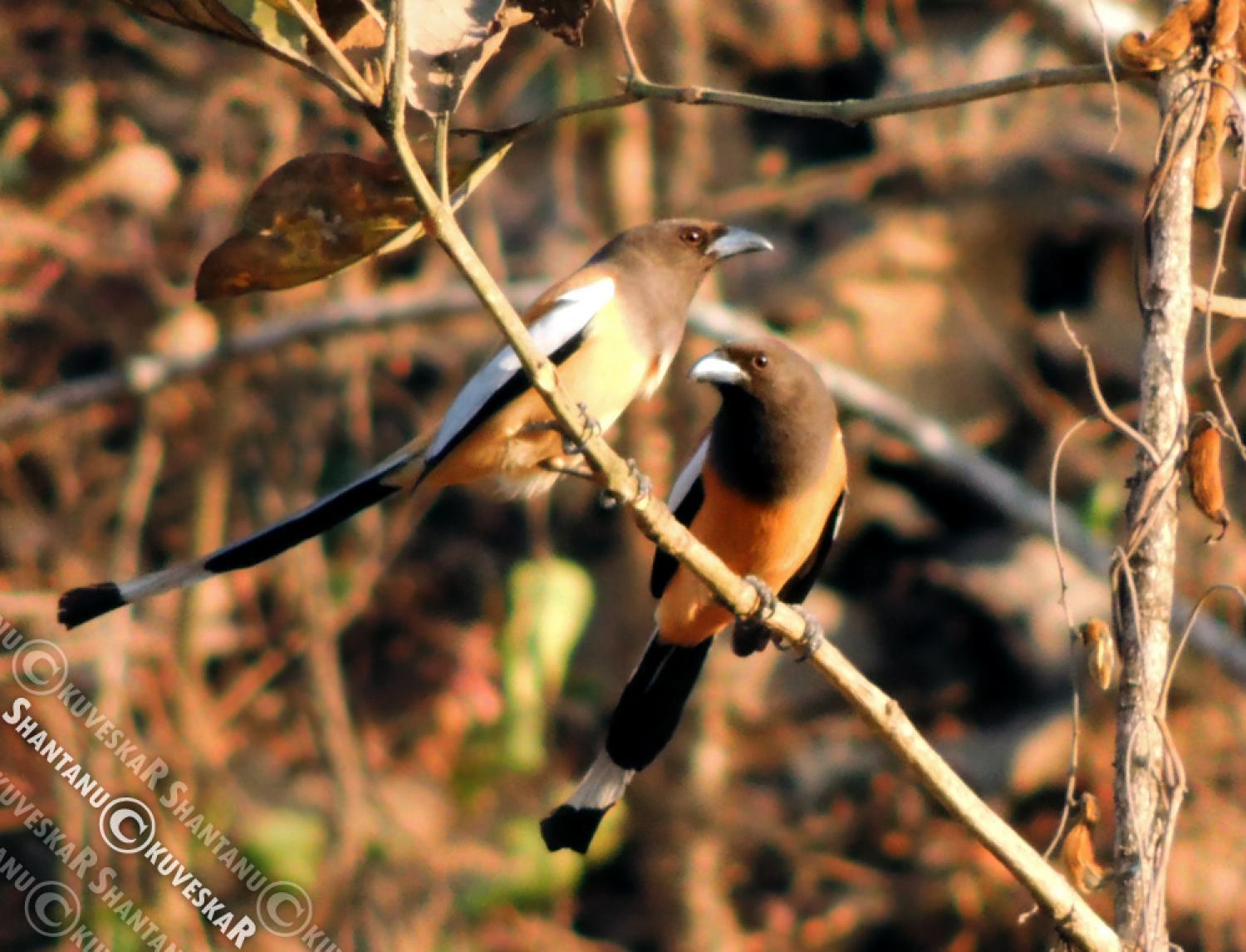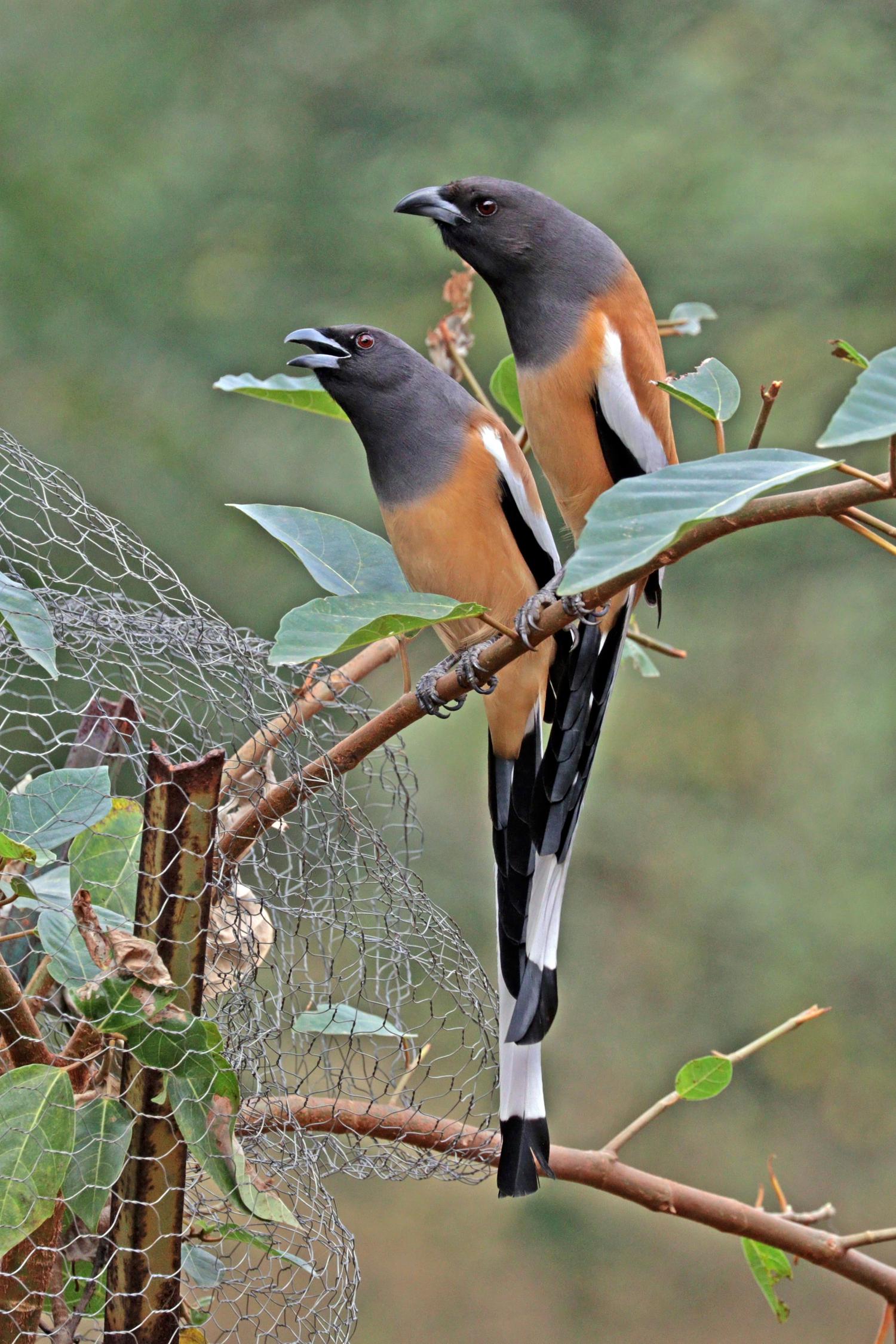Species of Thailand
Rufous treepie
Dendrocitta vagabunda
John Latham, 1790
In Thai: นกกะลิงเขียด
The rufous treepie (Dendrocitta vagabunda) is a treepie, native to the Indian Subcontinent and adjoining parts of Southeast Asia. It is a member of the crow family, Corvidae. It is long tailed and has loud musical calls making it very conspicuous. It is found commonly in open scrub, agricultural areas, forests as well as urban gardens. Like other corvids it is very adaptable, omnivorous and opportunistic in feeding.
Description
The sexes are alike and the main colour of the body is cinnamon with a black head and the long graduated tail is bluish grey and is tipped in black. The wing has a white patch. The only confusable species is the grey treepie which however lacks the bright rufous mantle. The bill is stout with a hooked tip. The underparts and lower back are a warm tawny-brown to orange-brown in colour with white wing coverts and black primaries. The bill, legs and feet are black.
The widespread populations show variations and several subspecies are recognized. The nominate subspecies is found in the northeastern part of peninsular India south to Hyderabad. The desert form is paler and called pallida, vernayi of the Eastern Ghats is brighter while parvula of the Western Ghats is smaller in size. The form in Afghanistan and Pakistan is bristoli while the form in southern Thailand is saturatior. E C Stuart Baker describes sclateri from the upper Chindwin to the Chin Hills and kinneari from southern Myanmar and northwest Thailand. The population in eastern Thailand an Indochina is sakeratensis.
Distribution and habitat
The range of the rufous treepie is quite large, covering Pakistan, India and into Bangladesh, Myanmar, Laos, and Thailand. It inhabits open forest consisting of scrub, plantations and gardens. In the Garhwal Himalayas, it migrates seasonally between different elevations.
Behaviour and ecology
The rufous treepie is primarily an arboreal omnivore feeding on fruits, nectar (of Bombax ceiba) seeds, invertebrates, small reptiles and the eggs and young of birds; it has also been known to take flesh from recently killed carcasses. It is an agile forager, clinging and clambering through the branches and sometimes joining mixed hunting parties along with species such as drongos and babblers. They are known to be a cleaning symbiont of deer, feeding on ectoparasites of sambar which permit them to perch and position themselves to invite the birds to examine specific parts. Like many other corvids, it caches food. It is considered to be beneficial to palm cultivation in southern India due to its foraging on the grubs of the destructive weevil Rhynchophorus ferrugineus. Its feeds on the fruits of Trichosanthes tricuspidata which are toxic to mammals.
The breeding season in India is April to June. In Bengal, the peak is in April and May with heightened levels of pineal gland activity and serotonin production. It builds its shallow nest in trees and bushes and usually lays 3-5 eggs.
The rufous treepie has a wide repertoire of calls, but a bob-o-link or ko-tree call is most common. A local name for this bird kotri is derived from the typical call while other names include Handi Chancha and taka chor (="coin thief").
A blood parasitic protozoan Trypanosoma corvi and Babesia has been reported from this species. Trematode parasites, Haplorchis vagabundi, have been found in their intestines. An acanthocephalan parasite Centrorhynchus lancea is also known. A species of quill mite Syringophiloidus dendrocittae is known to live in the feathers of rufous treepies.
This article uses material from Wikipedia released under the Creative Commons Attribution-Share-Alike Licence 3.0. Eventual photos shown in this page may or may not be from Wikipedia, please see the license details for photos in photo by-lines.
Category / Seasonal Status
BCST Category: Recorded in an apparently wild state within the last 50 years
BCST Seasonal status: Resident or presumed resident
Scientific classification
- Kingdom
- Animalia
- Phylum
- Chordata
- Class
- Aves
- Order
- Passeriformes
- Family
- Corvidae
- Genus
- Dendrocitta
- Species
- Dendrocitta vagabunda
Common names
- Thai: นกกะลิงเขียด
Synonyms
- Dendrocitta rufa
Conservation status

Least Concern (IUCN3.1)
Photos
Please help us review the bird photos if wrong ones are used. We can be reached via our contact us page.
Range Map

- Bang Phra Non-Hunting Area
- Chiang Dao District, Chiang Mai
- Chiang Dao Wildlife Sanctuary
- Chiang Saen District, Chiang Rai
- Doi Inthanon National Park
- Doi Lo District, Chiang Mai
- Doi Pha Hom Pok National Park
- Doi Saket District, Chiang Mai
- Doi Suthep - Pui National Park
- Hua Hin District, Prachuap Khiri Khan
- Huai Kha Khaeng Wildlife Sanctuary
- Kaeng Khoi District, Saraburi
- Kaeng Krachan District, Phetchaburi
- Kaeng Krachan National Park
- Khao Khiao - Khao Chomphu Wildlife Sanctuary
- Khao Sam Roi Yot National Park
- Khao Yai National Park
- Mae Ping National Park
- Mae Rim District, Chiang Mai
- Mae Taeng District, Chiang Mai
- Mae Wong National Park
- Mueang Chiang Mai District, Chiang Mai
- Mueang Chumphon District, Chumphon
- Mueang Kamphaeng Phet District, Kamphaeng Phet
- Mueang Lampang District, Lampang
- Mueang Nakhon Nayok District, Nakhon Nayok
- Mueang Nonthaburi District, Nonthaburi
- Mueang Ratchaburi District, Ratchaburi
- Mueang Surin District, Surin
- Mueang Tak District, Tak
- Nam Nao National Park
- Nanthaburi National Park
- Nong Ya Plong District, Phetchaburi
- Pa Sang District, Lamphun
- Pak Kret District, Nonthaburi
- Pang Sida National Park
- Pha Taem National Park
- Phatthana Nikhom District, Lopburi
- Pho Prathap Chang District, Phichit
- Phu Hin Rong Kla National Park
- Phu Khiao Wildlife Sanctuary
- Phu Soi Dao National Park
- Sai Yok District, Kanchanaburi
- Sakaerat Environmental Research Station
- Samut Prakan Province
- Ta Phraya National Park
- Taphan Hin District, Phichit
- Tha Yang District, Phetchaburi
- Thap Lan National Park
- Thung Yai Naresuan Wildlife Sanctuary
- Wang Chan District, Rayong
- Wapi Pathum District, Maha Sarakham
- Wat Phai Lom & Wat Ampu Wararam Non-Hunting Area


